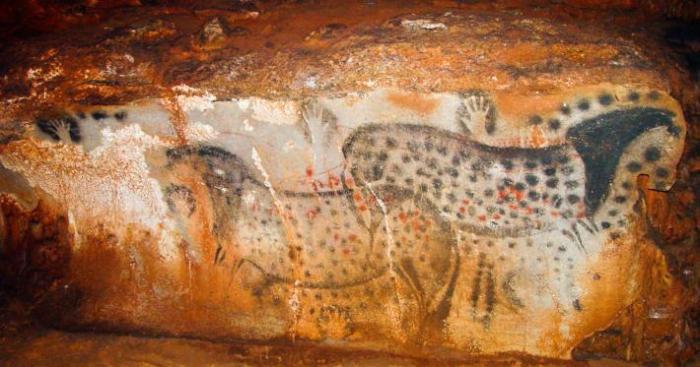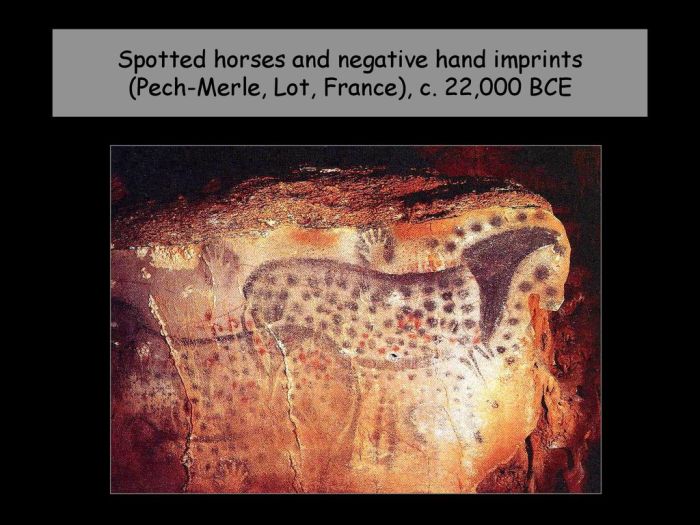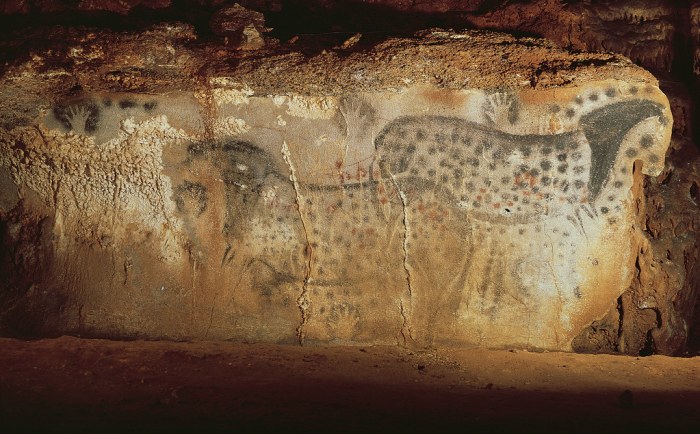Spotted horses and negative hand imprints emerge from the annals of history and culture, intertwining in a captivating tapestry of symbolism and meaning. From the vibrant coats of Appaloosas to the enigmatic handprints adorning ancient cave walls, these elements have captivated imaginations and sparked countless interpretations.
Their unique characteristics and shared cultural significance invite us on an enthralling journey to unravel the connections between these seemingly disparate entities, uncovering the hidden narratives and profound meanings they embody.
Spotted Horses

Spotted horses exhibit distinctive coat patterns characterized by irregular patches of white or other colors against a base coat color. These patterns range from small, scattered spots to large, prominent markings that cover significant portions of the body.
The origins of spotted horses can be traced back to ancient times, with evidence of their existence in prehistoric cave paintings and archaeological findings. Selective breeding has played a significant role in the development of different spotted horse breeds, each with unique characteristics.
Breeds of Spotted Horses
- Appaloosa:Known for their distinctive leopard spot pattern, Appaloosas also exhibit other markings such as snowflake patterns and mottled coats.
- Paint Horse:Paint horses feature large, bold patches of color, typically black or brown, on a white background.
- American Paint Horse:A specific breed developed from Paint horses, American Paint Horses have a wider range of colors and patterns.
- Knabstrupper:Originating in Denmark, Knabstruppers have a distinctive spotted pattern that can range from small to large and covers various colors.
- Nokota Horse:A rare breed with a distinctive spotted pattern that is believed to have originated from Native American horses.
Negative Hand Imprints

Negative hand imprints, also known as hand stencils, are representations of human hands created by placing a hand on a surface and applying a pigment or substance around it, leaving an Artikel of the hand. These imprints have been found in various cultures and historical contexts, often associated with ritualistic practices, communication, or artistic expression.
Examples of negative hand imprints can be seen in cave paintings, such as those found in the Chauvet Cave in France, dating back tens of thousands of years. They have also been discovered on ancient artifacts, including pottery, tools, and weapons.
Symbolism and Interpretations
- Ritualistic Practices:Negative hand imprints have been linked to rituals and ceremonies, representing connections with the spiritual realm, protection, or healing.
- Communication:In some cultures, hand imprints were used as a form of communication, leaving messages or marking territories.
- Artistic Expression:Negative hand imprints have been used as a form of artistic expression, creating patterns, designs, or representations of human presence.
Connections between Spotted Horses and Negative Hand Imprints
While there is no direct historical or cultural connection between spotted horses and negative hand imprints, there are some intriguing parallels and symbolic associations that can be explored.
Both spotted horses and negative hand imprints have been associated with ritualistic practices and spiritual beliefs. In some Native American cultures, spotted horses were considered sacred and were used in ceremonies. Similarly, negative hand imprints have been found in caves and on artifacts associated with ritualistic activities.
Possible Reasons for Connections, Spotted horses and negative hand imprints
- Symbolic Association with Nature:Both spotted horses and negative hand imprints can be seen as representations of the natural world, with spotted horses representing the beauty and diversity of nature, and negative hand imprints representing the human connection to the natural environment.
- Marking Territory:Negative hand imprints have been used to mark territories, while spotted horses have been used to identify and distinguish different herds. This shared characteristic may suggest a connection between the two elements.
Symbolism and Interpretation: Spotted Horses And Negative Hand Imprints
Individually, spotted horses and negative hand imprints carry rich symbolic meanings:
Spotted Horses:
- Beauty and Diversity:Spotted horses represent the beauty and diversity of the natural world, with their unique patterns symbolizing individuality and the interconnectedness of all living things.
- Spirituality and Power:In some cultures, spotted horses are associated with spiritual beings and are believed to possess supernatural powers.
- Freedom and Independence:The spotted horse’s ability to roam freely symbolizes freedom, independence, and the untamed spirit of nature.
Negative Hand Imprints:
- Human Presence:Negative hand imprints represent the human connection to the environment and a desire to leave a mark on the world.
- Communication:Hand imprints have been used to convey messages, share stories, or mark territories, symbolizing the power of communication.
- Ritual and Spirituality:Negative hand imprints have been associated with ritualistic practices and spiritual beliefs, representing connections to the divine or other realms.
Artistic Representations

Spotted horses and negative hand imprints have been depicted in various art forms throughout history:
Spotted Horses:
- Cave Paintings:Spotted horses have been featured in cave paintings, such as those found in Lascaux, France, showcasing their importance in prehistoric cultures.
- Sculptures:Bronze and stone sculptures of spotted horses have been created, capturing their beauty and grace.
- Paintings:Artists have used spotted horses as subjects in paintings, exploring their symbolism and connection to nature.
Negative Hand Imprints:
- Cave Paintings:Negative hand imprints are commonly found in cave paintings, such as those in the Chauvet Cave, France, providing insights into prehistoric human behavior.
- Ceramics:Negative hand imprints have been used to decorate pottery and other ceramic objects, adding a personal touch and symbolic meaning.
- Modern Art:Contemporary artists have incorporated negative hand imprints into their works, exploring themes of identity, memory, and the human connection to the past.
Modern Applications
In contemporary contexts, spotted horses and negative hand imprints continue to be used in art, design, and popular culture:
Spotted Horses:
- Fashion:Spotted horse patterns have been incorporated into clothing, accessories, and home décor.
- Photography:Spotted horses are often featured in photography, capturing their beauty and connection to nature.
- Entertainment:Spotted horses have appeared in films, television shows, and other forms of entertainment.
Negative Hand Imprints:
- Design:Negative hand imprints are used in design elements, such as logos, patterns, and artwork.
- Fashion:Hand imprints have been used as motifs in clothing, jewelry, and accessories.
- Popular Culture:Negative hand imprints have been featured in popular culture, including in films, television shows, and music videos.
FAQs
What is the significance of spotted horses in different cultures?
Spotted horses have been revered in various cultures, often associated with divine favor, healing powers, and spiritual connections.
How have negative hand imprints been interpreted throughout history?
Negative hand imprints have been found in diverse contexts, representing everything from personal signatures to symbols of protection, fertility, and communication with the spirit world.
What is the connection between spotted horses and negative hand imprints?
While the exact connection remains elusive, some theories suggest a shared symbolism related to fertility, healing, or spiritual protection.